April 19, 1991: Holyfield vs Foreman
When news came in 1987 that former heavyweight champion George Foreman, who had retired ten years before to become an evangelical pastor, was embarking on a wholly unexpected return to prizefighting, the reaction was one of collective disbelief. Surely this was some kind of practical joke; boxers don’t come back after decade-long retirements. But then photos surfaced of Foreman’s portly frame in the ring against a journeyman named Steve Zouski, the former champion’s massive paunch protruding over the waist band of the same red and blue trunks he had worn years before. The boxing intelligentsia collectively wagged their heads; this could only come to sorrow.
NBC boxing commentator Dr. Ferdie Pacheco echoed the thoughts of most: “This is pathetic,” he said. “It shouldn’t be allowed. He’s overage, inept. This whole thing is a fraudulent second career to build a big money fight with Mike Tyson.”
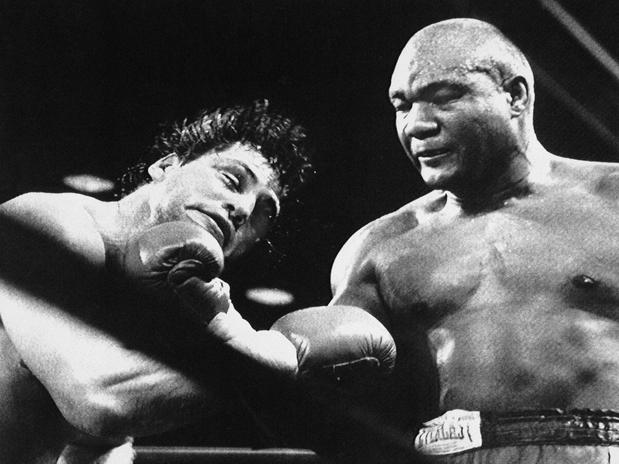
For the sport, the timing was not great. With the stars of the lower weight classes — Hagler, Leonard, Hearns, Duran — in decline, and the heavyweight champion of the world a repellent street thug, George’s bizarre comeback made boxing even more difficult to take seriously. Over the next two years, the bald and rotund Foreman journeyed to various unlikely fight towns, knocking out one fringe contender after another in places like Marshall, Texas and Anchorage, Alaska, while the sport of pugilism and baby-boomers across America cringed in embarrassment. Old, slow and fat — who wanted to be reminded so vividly and mercilessly of the passage of time? It was like the kids finding the Iron Butterfly or Sonny & Cher albums in the basement and laughing their asses off at the crappy music you once loved, except this was for the whole world to see. Give it up, George, please!
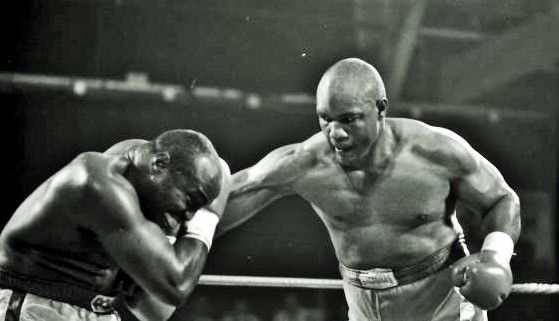
But while pundits and hardcore fans dismissed it all as a sideshow, Foreman, undeterred, kept fighting and kept winning, as gradually the public at large grew increasingly intrigued. By 1990 George had notched nineteen straight victories, all but one by stoppage. But the point when the bad joke turned into something else entirely came when Foreman scored a highlight reel knockout of former top contender and “great white hope” Gerry Cooney. Billed as “The Preacher vs The Puncher,” the match may have been dismissed by boxing purists, but sports fans knew an entertaining scrap when they saw one and sold out Caesars in Atlantic City to see George demolish Gerry inside of two wild rounds. The win legitimized Foreman, at least in the eyes of the public, putting him on the talk show circuit and drawing even more attention to his quest for the crown lost years before to Muhammad Ali.

Incredibly, Foreman was a major attraction again, and even prior to the Cooney bout he had been proposed as an opponent for Mike Tyson, the undefeated young champion. But “Kid Dynamite” walked away from a $20 million dollar payday and instead went to Tokyo for a one-sided beat-down from James “Buster” Douglas. A few months later the idea of a Tyson vs Foreman showdown again appeared possible after George was featured on the undercard of Iron Mike’s comeback fight, both men winning by knockout.
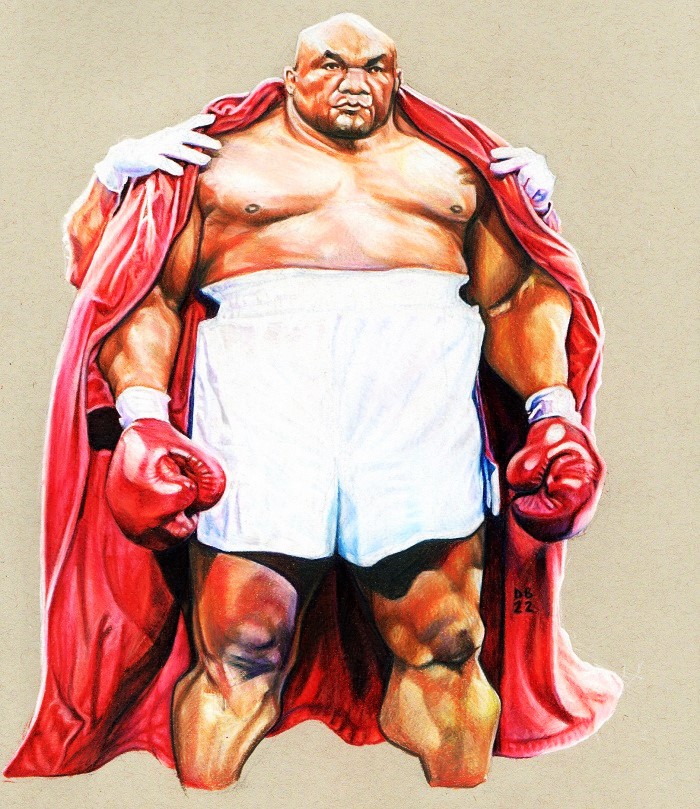
But Tyson, unlike so many, took the aging Foreman very seriously. A student of boxing history, he had grown up watching videos with Cus D’Amato of George bouncing Ken Norton and Smokin’ Joe Frazier off the canvas like rubber tires. The truth was Mike wanted no part of him, no matter how old and fat he looked. According to Don King’s longtime matchmaker Bobby Goodman, when King pressured Tyson to accept a Foreman fight, “Iron Mike” refused, shouting, “No! I ain’t fightin’ that animal! If you love him so much, you fight him!”
Buster Douglas then lost to Evander Holyfield, so instead of Tyson it was “Real Deal” Evander who got the big money showdown with the man chasing the impossible dream. Amazingly, Foreman’s dream came closer to being Holyfield’s nightmare than almost anyone expected.
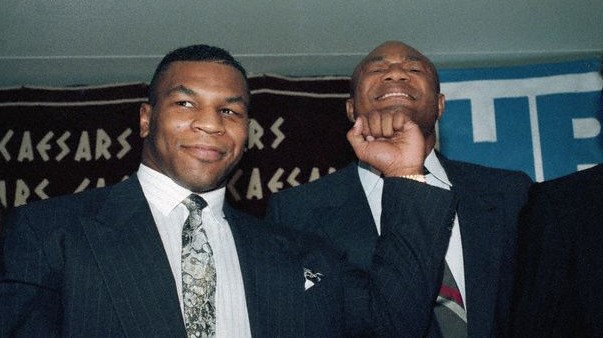
They billed it as “The Battle of the Ages,” with Holyfield a youthful 28 and Foreman, at 42, vying to be the oldest man to ever win the heavyweight title. The match attracted record pay-per-view sales with millions of homes tuning in and some twenty thousand filling the stands of Atlantic City’s Convention Center. And yet a mood of skepticism hung over the whole affair. Many feared the contest would prove farcical, that Foreman had duped the sport and the public to maneuver himself into commanding both the spotlight and a $12.5 million dollar payday. Was Foreman in fact a legit challenger for the world title he had lost seventeen years before? Or, as his constant stream of one-liners and his hamming it up for the press suggested to the cynical, was he little more than a shrewd self-promoter, a conman about to score the jackpot?
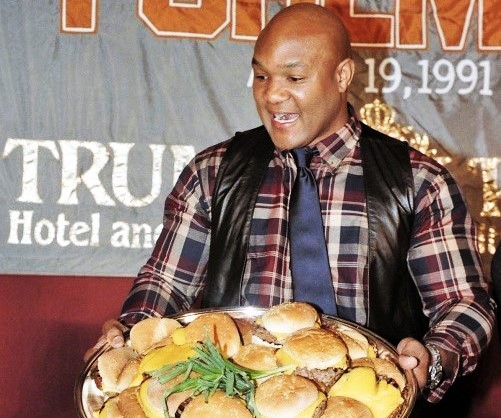
The majority of the boxing press shared the latter point of view. Many predicted a one-sided beating or an early exit for Big George. “It’s a farce,” declared one prominent boxing scribe to author Barney Nagler. “George hasn’t fought his way into this fight; he’s talked his way into it. I don’t see him getting through the second round.”
Thus, “The Battle of the Ages” was not a fight that inspired people to take sides. Most understood that Evander Holyfield — undefeated, fourteen years younger, and a four-to-one betting favorite — would likely win. So what compelled millions to put down their hard-earned cash to watch what so many dismissed as a mismatch? Nostalgia? Morbid curiosity? George Foreman’s newly likable personality and folksy humor? Maybe all of the above to some degree, but the real attraction, as it usually is with fights that transcend the sport, was a great story.
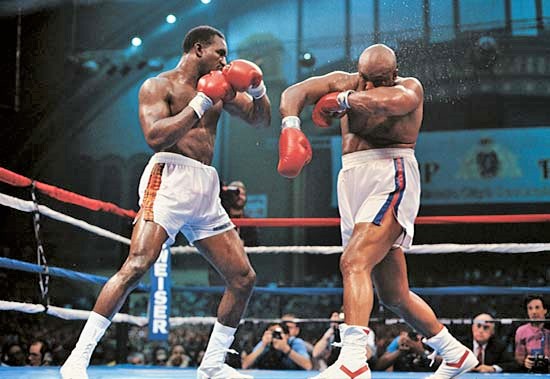
In retrospect, the surprising financial success of Foreman’s comeback shouldn’t have been so surprising. As all successful business people know, demographics are the key to making serious money. Foreman was born in 1949 and baby-boomer sports fans are as sought after a demographic as exists on the planet. At the beginning of his comeback, George was an object of ridicule, a painful reminder of age and time to his generation, but having soldiered on despite all the naysayers, his comeback had transformed itself into a compelling story of determination, redemption, and the courage to persevere in the face of overwhelming odds.
And for baby boomers, it wasn’t just a great story; it was now their story, as stirring at this late date as a Fleetwood Mac reunion or a re-screening of The Graduate. But the ending had yet to be determined. Was Foreman crafting a stirring saga of unlikely triumph, a Greek tragedy, or in the end, as many predicted, a farce?
As early as the second round, the massive worldwide audience and the sell-out crowd in Atlantic City had part of the answer. The opening stanza had highlighted Holyfield’s advantage in quickness as he took the fight to a steadily advancing Foreman, scoring with sharp volleys and then stepping out of harm’s way before the challenger could counter. In round two it was more of the same until Foreman found the mark with a pair of heavy left hooks that drove the champion to the ropes. A hard jab and then a powerful right appeared to stun Holyfield and the crowd came to its feet, roaring, as Foreman connected with two more thudding blows to the champion’s midsection, another right and then a left hook at the bell. It was now undeniable: Foreman had not come just to collect a huge payday. He had come to fight. And he had come to win.
Holyfield rebounded to take the third and fourth rounds by a wide margin, but, to the amazement of all who had been certain the contest would not last even this long, George hurt the champion again in the fifth with a sweeping left hook and then three hard right hands. The sixth belonged to Holyfield but Foreman, like an old grizzly bear determined to hunt down its prey, stayed in it with his younger, faster opponent and just kept coming, landing two big hooks before the bell.
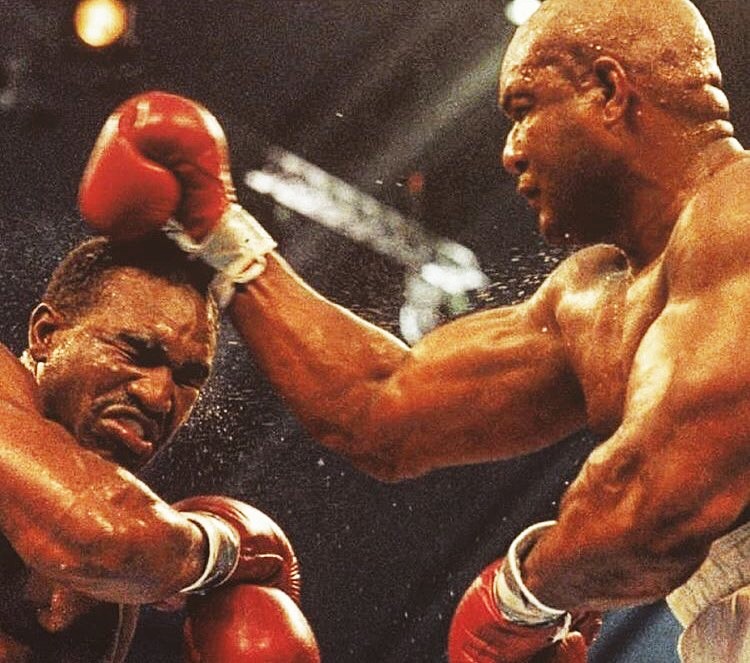
And in the seventh a surprisingly good heavyweight action fight turned into a ferocious war. Foreman struck with a huge right that staggered Holyfield and the former champion pounced, launching a fusillade of heavy shots that had the crowd on its feet and Evander almost off his. But then it was the champion’s turn to stun a winded Foreman with a shocking series of flush blows that had George teetering from side to side. Back and forth it went through the remainder of the round, both men giving and taking, as the challenger demonstrated once and for all that the new Big George, incredibly, at age 42, was actually tougher and possessed more stamina than the Foreman of the 1970’s.
Round seven was the bout’s, and George’s, high point; the eighth found Holyfield back in command and in the ninth he staggered the challenger with a right. In round ten, Foreman, who had been landing low blows and forearm shivers throughout the battle, lost a point for a hard shot south of the border. They continued to slug away in the final two rounds but, to everyone’s amazement, it was the much younger champion who appeared the more exhausted fighter, as he repeatedly clinched and hung on to get to the final bell.
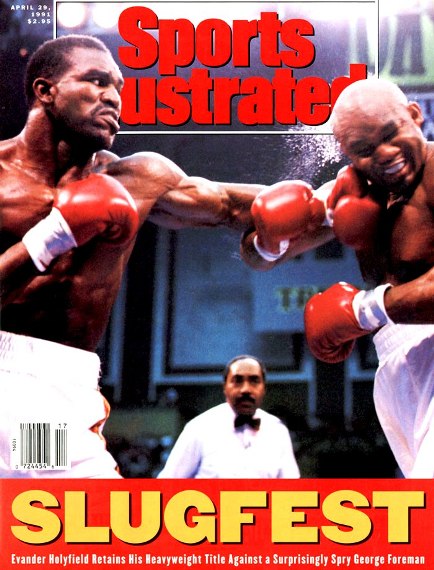
The unanimous decision in Holyfield’s favour was a formality; even George’s most ardent fans were hard-pressed to give him more than four rounds. But the final verdict hardly mattered. If ever a boxer found victory in defeat, it was the 1991 version of George Foreman, who not only proved that he was a legitimate top contender and that his worst critics were dead wrong, but who also forced boxing experts and historians to re-evaluate his standing in the heavyweight pantheon.
After his loss to Muhammad Ali, Foreman’s image and status had plummeted. Once regarded as the most fearsome heavyweight puncher since Joe Louis, he was no longer viewed as an elite champion. But now the question had to be asked: how many boxers could return from a decade-long layoff, win 24 straight fights, and then, at age 42, give the undefeated, reigning world champion one of the toughest battles of his career?
“He won the points,” said Foreman, referring to the decision, “but I proved the point.”
Indeed he did. A few points, in fact. That his comeback was not a joke or a farce. That the age of forty was not, as the former champion put it, “a death sentence.” And that George Foreman was something more than the slugger who had been felled in “The Rumble in the Jungle.” Like Ali, Big George was now bigger than boxing. And three-and-a-half years later, when he knocked out Michael Moorer with a single thunderous right hand to finally regain the heavyweight crown, he would become bigger still and assume the stature of a boxing legend. — Michael Carbert

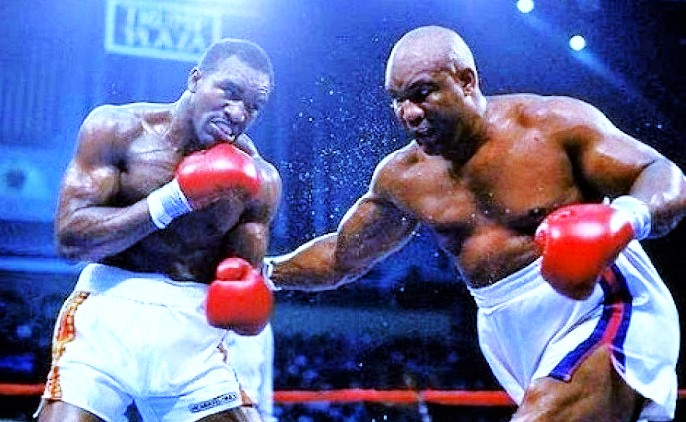
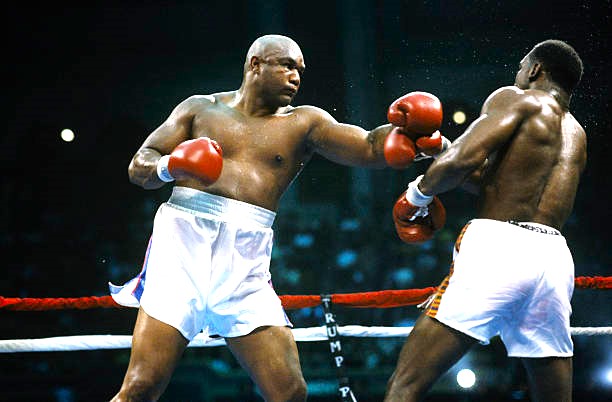

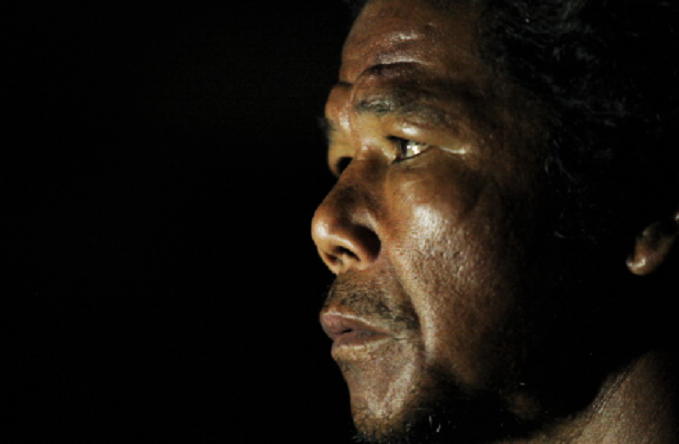
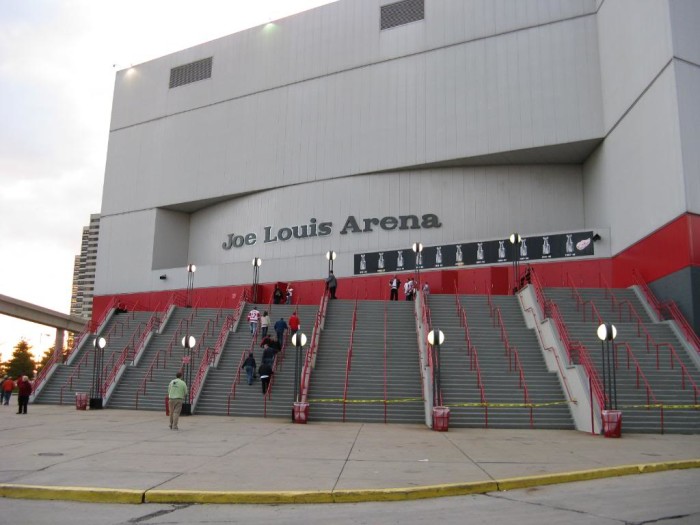
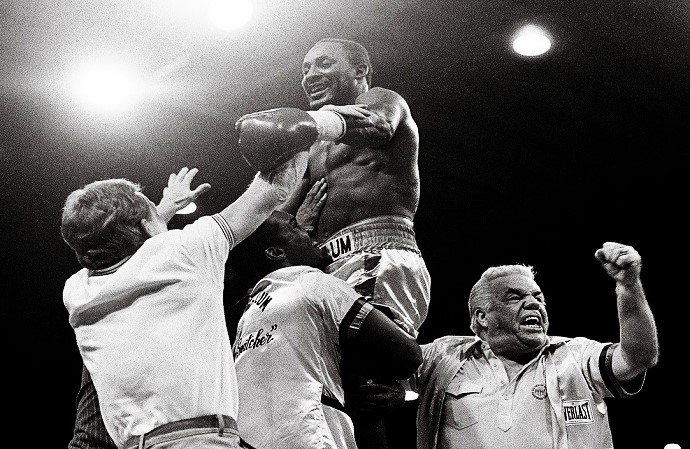
Amazing fight!
Now that I’m older, 42 doesn’t seem that old anymore! But probably it was more important financially for Foreman to get back in the spotlight and that eventually led to him getting the chance to endorse the George Foreman Grill. I understand the Hulkster had the first chance to endorse it but he turned it down to endorse a meatball maker or something.
Brilliant fight, the barrage of punches landed by Holyfield in the seventh is among the most vicious punches ever landed in combination…ever. Period.
Big George = HW LEGEND.
The “repellent street thug” line made my day, lol.
Tyson has become Jesus Christ. The internet fans who rate Tyson as one of the top ten of all time despite never beating ANY HOF fighters…Frank Bruno?? And place him ahead of Foreman. It just goes to show you history isn’t the point of view of the winner but rather the most popular.
Ha. Tyson a joke? He made his opponents look like first year amateurs. That’s why casual fans believed they were tomato cans. Tyson with Kevin Rooney would have went undefeated forever.
George Foreman is no joke years later Holyfield said Foreman was the hardest puncher he ever faced.
Respect.
This article is a lot of BS. In 1987 boxing was not in decline. Tyson was the most popular heavyweight since Ali and this was five years before the rape conviction. Chavez was on his way to stardom. Iran Barkely was beating the crap out of Hearns. In 1991 I was a freshman in college and I watched the Holyfield vs Foreman fight. It wasn’t close and Holyfield was never in danger of being KO’d. Also, you can’t say this version of Foreman was tougher than the 70s version. Have you seen the Foreman vs Lyle fight? Lastly, Foreman got beat up by Alex Stewart after this, then outboxed by Tommy Morrison, and was not taken seriously again when he shocked Moorer. Don’t make it sound like this fight legitimized him. He was given little chance of beating Moorer and it was a total shock when he did. I do consider Foreman an all time great, but not because of his second career.